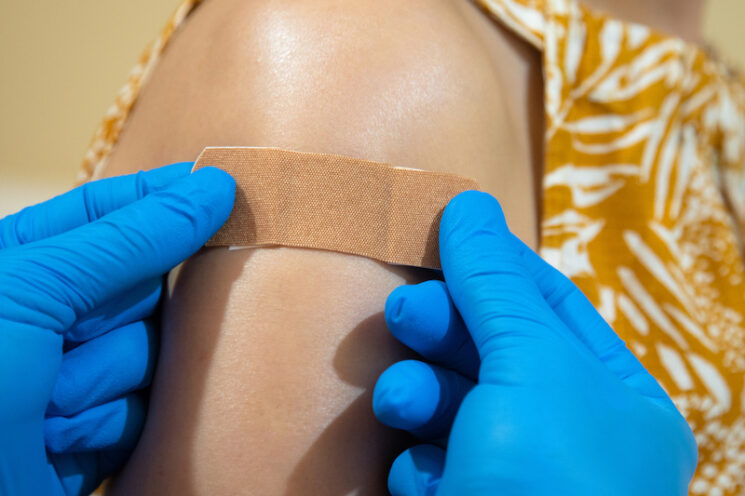
By Hannah Park
OCTOBER 2022: Three years into the coronavirus disease of 2019 (COVID-19) pandemic and seven months since California lifted its indoor mask mandate, the death toll shows signs of flattening. Omicron continues to infect Californians: a variant that is reportedly milder than the original strain but more contagious.
“We are pretty much in the end and new normal phase,” Fountain Valley High School (FVHS) Nurse Marci McLean-Crawford said. “We call this endemic.”
Endemic describes the stage in which a disease is still present, but spreads steadily and does not disrupt daily life. This stage is remarkably different from a pandemic, which is widespread and grows exponentially.
At FVHS, the number of COVID-19 cases is leveling out.
Principal Paul Lopez said that he sees only “six to 10 [positive cases] every few weeks.”
“Since last January, we haven’t had that huge uptick [in cases],” Lopez said. “I think we have gotten through the worst of it.”
Admittedly, the exact number cannot be determined.
“[M]any staff or families are not testing when they are symptomatic,” McLean-Crawford said. “It is unfortunate but true [that] we have several viruses that have lots of the same symptoms: flu, para influenza, colds, allergies, strep throat… just to name a few.”
From the available data, the only significant spike in cases occurred after the Aloha Dance. Mass gatherings have always led to increased infections. Nevertheless, students should still be careful.
“What we’re seeing now, alongside COVID, is the regular cold and flu season. Because people are getting sick, but… they’re not positive for COVID,” Lopez said.
Vaccination may protect students from flu viruses to the newest COVID-19 variants. In the first half of 2022, unvaccinated Californians were five times more likely to die from COVID-19.
“Both flu and COVID vaccines are made to [prevent you from landing] in the hospital,” McLean-Crawford said. “You [will be] able to feel better sooner.”
There are now a variety of boosters for COVID-19. Every student and staff member should consult their physician to find the vaccine that is best for them.
McLean-Crawford said, “[There is] a newer booster out that is bivalent [which means it] has parts of the original virus strain… and parts of the Omicron variant.”
Remarkably, the booster provides broad protection against both strains.
Moreover, the Orange County Health Care Agency (OCHCA) still recommends masking in crowded indoor public spaces, like the aforementioned school dances.
“Wearing a mask remains a personal choice,” McLean-Crawford said.
For the foreseeable future, though, things are getting back to normal. The Huntington Beach Union High School District’s COVID-19 Dashboard, which tracked student and staff cases in the district, has been discontinued. Contact tracing is no longer as vigorous.
Lopez still sends out ParentSquares informing families about new cases. However, they are addressed to the general community and are no longer specific to classrooms.
Students share their thoughts about the pandemic and the return to normalcy.
“People aren’t taking it as seriously anymore… [they] aren’t wearing masks or social distancing,” junior Raquel Anaya said. “For the most part, everything’s back to normal: people [just ignore] new cases now.”
“I believe that the original pandemic is over (like the one from 2020), but for a while, we’ll probably have waves of colds and COVID,” senior Natalie Sellers said. “I haven’t really known ‘normal’ since freshman year when a two-week break turned into a global pandemic… but now I’m living in a new normal.”
Some things have changed for the worse, but overall, “it’s not a bad new normal,” Lopez said.
As one example, FVHS students who miss class often have access to lectures recorded during the online stage of the pandemic. On a larger scale, the United States is learning the value of wearing masks. When people are ill, wearing them can limit the risk of spreading not only COVID-19 but other respiratory illnesses as well.
Lopez said that personal protection equipment (PPE), like masks, will always be made available at indoor events.
“We will always keep them out the front gate… in case [people] want to mask,” Lopez said. “But I think continuing with the optional is a good way for schools to go.”
“[When you are sick, masking can] keep others safe and yourself safe,” Lopez said. “Wearing a mask and still being able to come to school and do some of your regular activities is not a bad thing.”
COVID-19 is drifting away, and everyone at FVHS can help to hasten the process. With outstanding medical advances, monitoring one’s health becomes even easier.
“If we get sick, we can go to the doctor and test to figure out if it is flu, strep, mono, or COVID,” McLean-Crawford said. “When you can use the process of elimination, it helps.”
And, when dealing with the other “side effects” of COVID, such as mental health issues, Lopez has some advice.
“Since last year, we talked about Barons All Together, and Barons for Life… sometimes students get into that space where they don’t see a way out,” Lopez said. “When you notice that about a friend, you have to reach out.”
“We can solve any problem that’s happening on campus… [if] we’re here for each other,” Lopez said. “That’s what we do as a campus in Fountain Valley. We all support each other.”
Whether building a vast support system or surviving through three years of a weary pandemic, FVHS students have proven that they can withstand anything.





